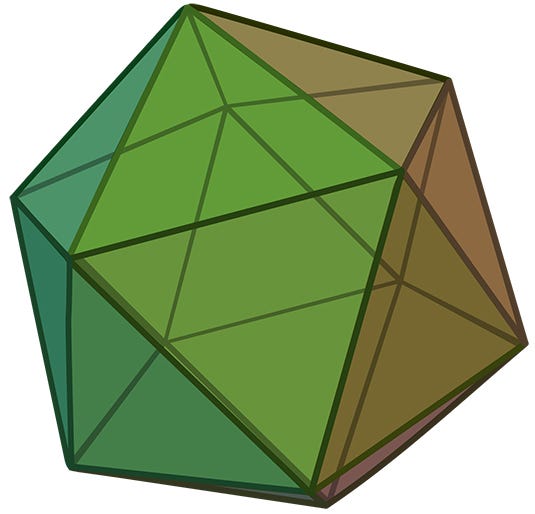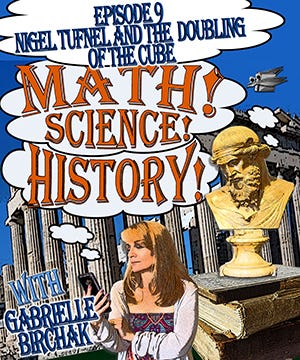Exploring the Fascinating World of Pseudomathematics
Written on
Chapter 1: The Significance of the Number Three
The number three holds a unique place in various fields, not merely due to its catchy association with the iconic School House Rock song. It’s a pivotal element in storytelling, often forming the foundation of the three-act structure in screenwriting, and is similarly represented in character dynamics. When it comes to stability, a three-legged table—commonly known as a tripod—outperforms its four-legged counterpart. In geometry, three connected orthogonal rectangles outline the vertices of a regular icosahedron.

The number three serves as a rough approximation of Pi and stands as the first Fermat Prime, expressed as 2k+1=3 (where k>0). In photography, the rule of thirds enhances composition by positioning subjects within the left or right third of the frame. Many songs leverage this three-part structure, typically comprising a verse, chorus, and bridge. Additionally, forming a major chord involves using three notes spaced three keys apart, such as C, E, and G.
Thus, it’s clear that the number three is quite impactful. Numerologists associate it with creativity, energy, and potential, symbolizing the past, present, and future. However, it's essential to recognize that numerology is regarded as a pseudoscience, and while three may seem magical, its properties cannot be empirically verified. Similarly, pseudoscience often masquerades as scientific inquiry, yet lacks the rigorous methodology that defines true scientific practice.
The realm of mathematics also has its share of challenges. Some mathematical equations remain unsolvable, regardless of the claims made by self-proclaimed mathematicians who assert they’ve found miraculous solutions. Many of these unsolvable equations have existed for millennia, remaining elusive due to their inherently impossible nature. This phenomenon, where individuals attempt to solve these complex problems through simplistic, unverified means, is referred to as pseudomathematics or mathematical crankery.
Pseudomathematical claims have surfaced regarding the Millennium Prize Problems, Fermat’s Last Theorem, the Collatz Conjecture, and classic challenges such as the Squaring of the Circle, Doubling of the Cube, and Trisection of the Angle. Those who claim to have resolved these unsolvable issues without presenting a robust mathematical framework are labeled as pseudomathematicians or mathematical cranks—distinct from the occasionally irritable mathematician we may encounter.
Section 1.1: The Quadrature of the Circle
In 1851, John R Parker published a book titled The Quadrature of the Circle, in which he asserted that he had solved this notorious problem. The essence of the squaring of the circle lies in creating a square with the same area as a circle using only a compass and straightedge. However, this task is fundamentally impossible due to Pi being an irrational and transcendental number, rendering it non-constructible. Despite this, Parker remained steadfast in his claims, even when faced with critiques from the mathematical community.

Another enduring challenge is the Doubling of the Cube, a topic discussed in the Math! Science! History! Podcast episode featuring Nigel Tufnel. This ancient problem, possibly originating over 2000 years ago, led to such an influx of solutions that by the 18th century, the French Academy declared it would no longer consider any further proposed solutions to the Doubling of the Cube, Squaring of the Circle, or Trisection of the Angle. This was one of the earliest indications from academia that pseudomathematics was a widespread issue among non-professionals.
This video, titled "Pseudomathematics," provides insights into the misconceptions surrounding mathematics and highlights the challenges of solving complex problems.
Section 1.2: The Collatz Conjecture
The Collatz Conjecture begins with the selection of any number—let’s choose 42, which is famously known as the answer to life’s ultimate question. The rules dictate that if the number is odd, it gets multiplied by three and increased by one; if it’s even, it’s divided by two.
Following this process with 42:
- It’s even, so 42 ÷ 2 = 21.
- 21 is odd, thus 21 × 3 + 1 = 64.
- 64 is even, so 64 ÷ 2 = 32.
- Continuing this process leads to the sequence: 32 → 16 → 8 → 4 → 2 → 1.
Once at 1, we multiply by three and add one, cycling back into the 4–2–1 loop. This conjecture posits that no matter which number you start with, you’ll ultimately find yourself in this loop.
Mathematicians, however, should not be hastily labeled as pseudomathematicians simply for attempting to tackle these challenging problems. On September 8, 2019, the esteemed mathematician Dr. Terrence Tao presented a partial proof for the Collatz Conjecture, suggesting it is “almost” true for “almost” all numbers, yet he did not definitively solve it. This illustrates the complexity and ongoing nature of mathematical inquiry.
Chapter 2: The Evolution of Pseudomathematics
The term pseudoscience first emerged in the early 17th century, linked to discussions about religion and imperialism. The term 'pseudoscience' was later applied by historian James Pettit Andrew in 1796, when he described alchemy as a “fantastical pseudoscience.” This was significant as it paved the way for chemistry, a field grounded in empirical science.
The term pseudomathematics was coined in 1915 by mathematician Augustus de Morgan in his work A Budget of Paradoxes. He described a pseudomathematician as someone who mishandles mathematics, akin to a monkey trying to use a razor—observing without understanding, leading to self-harm. De Morgan notably criticized James Smith for claiming that Pi equals exactly 3 and 1/8, establishing the term's negative connotation in mathematics.
Yet, it’s essential to distinguish enthusiasm for mathematics from pseudomathematics. Peer review plays a crucial role in validating mathematical work. Through this process, mathematicians can refine their theories, ensuring their findings are sound and logical. Without peer review, claims presented as truth may simply reflect mathematical crankery.
Returning to Mr. Parker and his assertions in The Quadrature of the Circle, it’s noted that he reacted defensively to criticism, even resorting to insults against those who evaluated his work. Similarly, Carl Theodore Heisel, who also claimed to have squared the circle, dismissed decimal fractions as imprecise while attempting to undermine the Pythagorean Theorem.
Nevertheless, pursuing the unsolvable is a noble endeavor. Engaging with these puzzles can expand one’s perspective and inspire a deeper understanding of mathematics. They create opportunities for discourse and collaboration within the mathematical community. You don’t need an advanced degree to tackle these challenges; you might just find yourself inspired to explore mathematics, physics, chemistry, or history further.
This video, titled "Have you ever heard of pseudomath?" dives into the intriguing world of pseudomathematics, exploring its implications and challenges in understanding mathematics.